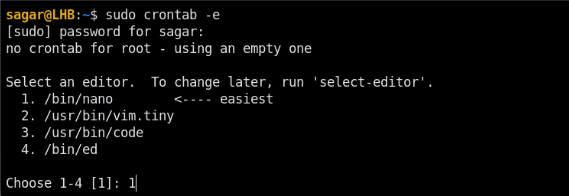 Operation and Maintenance
Operation and Maintenance
 Nginx
Nginx
 What is the /tmp directory used for in Linux? How is it different from /var/tmp?
What is the /tmp directory used for in Linux? How is it different from /var/tmp?
What is the /tmp directory used for in Linux? How is it different from /var/tmp?

If you have used a Linux system, then you must know the /tmp directory, but...if you don’t use it much, you may only know this directory That’s it, you don’t necessarily have the opportunity to understand it in depth.
In addition, there is a /var/tmp directory, which looks similar. Today we will learn about the /tmp directory and its difference from the /var/tmp directory.
What is the /tmp directory used for?
tmp is the abbreviation of the English word temporary. As the name suggests, it is used to store temporary files, such as temporary (required in a short period of time) data used by the system and applications. In most Linux distributions, the tmp directory is pre-configured to be automatically cleared after a system restart.
For example, when we install software in the system, the installation program will store some temporary files that need to be used in the /tmp directory.
For another example, when processing certain projects, the system may temporarily store changed files in the /tmp directory, or the automatically saved version of the file may also be stored in /tmp in the directory.
Generally speaking, the /tmp directory is used to store some temporary files. When these files are no longer needed, they can be deleted.
Are the /tmp and /var/tmp directories the same?
the answer is negative. There are significant differences between the /tmp directory and the /var/tmp directory. Although they are both used to handle temporary files, the processing methods are different.
In general, the /tmp directory is used to store short-term temporary files, while the /var/tmp directory is used to store long-term temporary files.
Specifically:
Endurance: Typically, files stored in the /tmp directory Will be deleted when the system starts, but the files in /var/tmp will not be deleted;
User permissions and system scope (For user VS Systemwide): Generally speaking, every user can access files in the /tmp directory, while most of the files in /var/tmp are for specific users;
Usage ( Usage): This is the most critical difference. The /tmp directory is used to store files that are needed for a short period of time, such as installing software packages, while the /var/tmp directory is used for files that are needed for a longer period of time, such as system backups or log files.
Automatically clean up the tmp directory
We mentioned in the previous article that for most Linux distributions, the /tmp directory will be automatically cleaned up when the system restarts.
If this is the case, why do we need to actively clean up the /tmp directory? Because you don't shut down or restart the system every day like you do with a Windows system, some Linux users will not restart the system for weeks, months, or even years.
Of course, not everyone needs to clean up the /tmp directory. Only when your server has insufficient disk space, you need to actively clean up the /tmp directory.
To automatically clean up the /tmp directory, the most important thing is to first clarify the content to be deleted. The best way is to delete files that have not been used in the past three days and do not belong to the root user.
Based on this principle, we can use the following command:
sudo find /tmp -type f \( ! -user root \) -atime +3 -delete
But the above command cannot be automated yet. Therefore, we need to create a corn job to automate this.
sudo crontab -e
You may be asked to choose a text editor if this is your first time using a cron table. You can choose according to your own habits, such as vim or nano.

Paste the following at the end of the file:
0 0 * * * sudo find /tmp -type f ! -user root -atime +3 -delete
Save changes That’s it.
The above is the detailed content of What is the /tmp directory used for in Linux? How is it different from /var/tmp?. For more information, please follow other related articles on the PHP Chinese website!

Hot AI Tools

Undresser.AI Undress
AI-powered app for creating realistic nude photos

AI Clothes Remover
Online AI tool for removing clothes from photos.

Undress AI Tool
Undress images for free

Clothoff.io
AI clothes remover

Video Face Swap
Swap faces in any video effortlessly with our completely free AI face swap tool!

Hot Article

Hot Tools

Notepad++7.3.1
Easy-to-use and free code editor

SublimeText3 Chinese version
Chinese version, very easy to use

Zend Studio 13.0.1
Powerful PHP integrated development environment

Dreamweaver CS6
Visual web development tools

SublimeText3 Mac version
God-level code editing software (SublimeText3)

Hot Topics
 1662
1662
 14
14
 1419
1419
 52
52
 1311
1311
 25
25
 1262
1262
 29
29
 1235
1235
 24
24
 Linux Architecture: Unveiling the 5 Basic Components
Apr 20, 2025 am 12:04 AM
Linux Architecture: Unveiling the 5 Basic Components
Apr 20, 2025 am 12:04 AM
The five basic components of the Linux system are: 1. Kernel, 2. System library, 3. System utilities, 4. Graphical user interface, 5. Applications. The kernel manages hardware resources, the system library provides precompiled functions, system utilities are used for system management, the GUI provides visual interaction, and applications use these components to implement functions.
 How to check the warehouse address of git
Apr 17, 2025 pm 01:54 PM
How to check the warehouse address of git
Apr 17, 2025 pm 01:54 PM
To view the Git repository address, perform the following steps: 1. Open the command line and navigate to the repository directory; 2. Run the "git remote -v" command; 3. View the repository name in the output and its corresponding address.
 vscode Previous Next Shortcut Key
Apr 15, 2025 pm 10:51 PM
vscode Previous Next Shortcut Key
Apr 15, 2025 pm 10:51 PM
VS Code One-step/Next step shortcut key usage: One-step (backward): Windows/Linux: Ctrl ←; macOS: Cmd ←Next step (forward): Windows/Linux: Ctrl →; macOS: Cmd →
 What is the main purpose of Linux?
Apr 16, 2025 am 12:19 AM
What is the main purpose of Linux?
Apr 16, 2025 am 12:19 AM
The main uses of Linux include: 1. Server operating system, 2. Embedded system, 3. Desktop operating system, 4. Development and testing environment. Linux excels in these areas, providing stability, security and efficient development tools.
 How to run java code in notepad
Apr 16, 2025 pm 07:39 PM
How to run java code in notepad
Apr 16, 2025 pm 07:39 PM
Although Notepad cannot run Java code directly, it can be achieved by using other tools: using the command line compiler (javac) to generate a bytecode file (filename.class). Use the Java interpreter (java) to interpret bytecode, execute the code, and output the result.
 How to run sublime after writing the code
Apr 16, 2025 am 08:51 AM
How to run sublime after writing the code
Apr 16, 2025 am 08:51 AM
There are six ways to run code in Sublime: through hotkeys, menus, build systems, command lines, set default build systems, and custom build commands, and run individual files/projects by right-clicking on projects/files. The build system availability depends on the installation of Sublime Text.
 laravel installation code
Apr 18, 2025 pm 12:30 PM
laravel installation code
Apr 18, 2025 pm 12:30 PM
To install Laravel, follow these steps in sequence: Install Composer (for macOS/Linux and Windows) Install Laravel Installer Create a new project Start Service Access Application (URL: http://127.0.0.1:8000) Set up the database connection (if required)
 How to use VSCode
Apr 15, 2025 pm 11:21 PM
How to use VSCode
Apr 15, 2025 pm 11:21 PM
Visual Studio Code (VSCode) is a cross-platform, open source and free code editor developed by Microsoft. It is known for its lightweight, scalability and support for a wide range of programming languages. To install VSCode, please visit the official website to download and run the installer. When using VSCode, you can create new projects, edit code, debug code, navigate projects, expand VSCode, and manage settings. VSCode is available for Windows, macOS, and Linux, supports multiple programming languages and provides various extensions through Marketplace. Its advantages include lightweight, scalability, extensive language support, rich features and version



